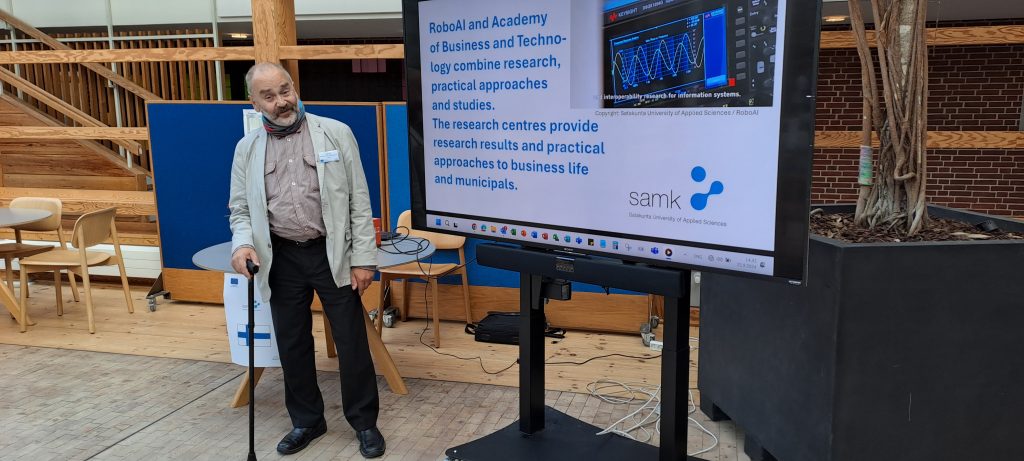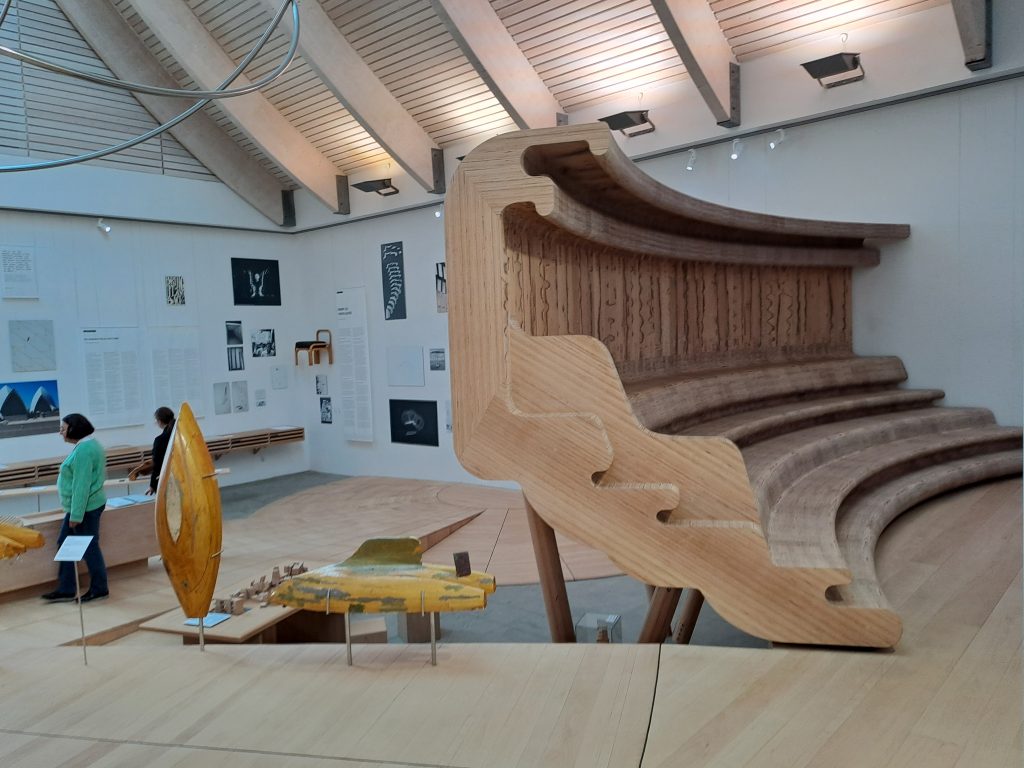Kari Lilja, TkT, Erikoistutkija; Sirpa Sandelin, TkT, Yliopettaja
English version: Click the link
Laajasta hankesalkustamme on kaksi hanketta päättymässä ensi vuoden alkupuolella: Dig-Con ja Sustainabuild. Molempia yhdistää, kuten nimetkin englantia taitavalle kertovat, rakentaminen. Dig-Con pyrkii edistämään digitaalisten työkalujen ja menetelmien käyttöä pienissä ja keskisuurissa rakennus- ja pintakäsittelyalan yrityksissä. Sustainabuildin puitteissa puolestaan toteutettiin viiden opintopisteen kansainvälinen kurssi kestävän kehityksen tavoitteiden soveltamisesta rakennusalalla ja sitä tukeva käsikirja. Lisäksi julkaistiin tieteellisiä artikkeleita kestävän kehityksen tavoitteiden roolista ja huomioimisesta rakennusliiketoiminnassa.

Perinteisen tavan mukaan hankkeiden tuotoksia esitellään yhdessä tai kahdessa julkisessa konferenssissa. Dig-Conin osalta konferenssit tullaan pitämään tammi-helmikuun taitteessa on-line-konferensseina eli webinaareina korona-ajan hengen mukaisesti. Sustainabuildin osalta loppuseminaari pidettiin 25.9.2024 Aalborgissa fyysisenä konferenssina, johon toki oli mahdollisuus osallistua myös verkon välityksellä. Kokouspaikkana oli yksi pääpartneri UCN:n kampuksista, vuonna1963 rakennettu entinen opettajaseminaari, joka oli saneerattu kauniiksi ja valoisaksi oppimisympäristöksi. Osanottajien joukossa oli UCN:n opiskelijoiden lisäksi myös yritysten edustajia ja muita aiheesta kiinnostuneita. Verkon kautta konferenssia seurasi myös muiden projektiin osallistuneiden ammattikorkeakoulujen opiskelijoita ja henkilökuntaa.

Projektin päättävä viimeinen workshop oli puolestaan Aalborgin yliopiston arkkitehtuurin, muotoilun ja mediateknologian laitoksella (Create – Department of Architecture, Design and Media Technology). Kampuksella kävi monilla eri tavoin selväksi, kuinka tärkeä rooli puurakentamisella on tanskalaisessa rakentamisessa ja erityisesti kestävässä rakentamisessa. Paitsi että kampus itse oli osin puusta tehty, kampuksen muotoilun ja arkkitehtuurin näyttelytiloissa esiteltiin perinteisen rakentamisen lisäksi modernia puurakentamista ja esillä oli myös puusta tehtyjä käyttöesineitä, huonekaluja ja pienoismalleja. Yhtymäkohtia ja virikettä myös Wood4Youth – hankkeeseemme oli yllin kyllin.

Jonkinlaisena jälkikaneettina – mitä Sustainabuildista opittiin, voisi nostaa esille eri maiden erilaiset lähestymistavat kestävän kehityksen tavoitteisiin. Suomessa ei rakennushankkeisiin liittyvien kestävän kehityksen tavoitteiden esille nostamista ja erikseen nimeämistä koeta yhtä tärkeäksi kuin joissakin muissa maissa. Siinä missä jossakin muualla listataan rakennuksen seinälle tavoitteet ja miten rakennus niihin vastaa, Suomessa saatetaan vain todeta, että rakennus on hiilineutraali, tai että rakennus täyttää energiatehokkuusvaatimukset. Tästä huolimatta tavoitteisiin vastaaminen voi Suomessa olla huomattavasti kattavampaa kuin monissa muissa maissa.
Kulttuurierot eri maiden välillä tulivat selvästi esille myös suhtautumisessa projektityöhön ja projektin tuotoksiin. Kun muut partnerit esimerkiksi halusivat painottaa käsikirjan ulkoasua, suomalaiset olisivat halunneet edetä asiat ja niiden oikeellisuus edellä. Projektityöhön liittyen opimme jälleen sen, että tuotosten onnistumisen kannalta nimenomaan LP:n rooli ohjaavana ja yhteen kokoavana voimana on erityisen tärkeä ja korostunut.
Dig-Conin viimeinen face-to-face workshop pidettiin Latvian pääkaupungissa Riiassa samaan aikaan 3LOE-hankkeen loppukonferenssin kanssa. Kokousten välillä meidät vietiin tutustumaan Riian ulkoilmamuseoon, joka on Helsingin Seurasaarta vastaava paikka. Museon alueella on noin 100 rakennusta, joista vanhimmat ovat 1600-luvulta. Tästäkin tilaisuudesta saatiin linkki Wood4Youth -hankkeeseen, sillä ulkomuseo oli erinomainen perinteisen puurakentamisen näyttely ja oppimistapahtuma.

English version
The last ones are taken…
From our extensive project portfolio, two projects are ending at the beginning of next year: Dig-Con and Sustainabuild. Both are connected, as the names tell those who know English, by construction. Dig-Con aims to promote the use of digital tools and methods in small and medium-sized companies working on construction and finishing branches. Within the framework of Sustainabuild, an international course of five credit units on the application of sustainable development goals in the construction industry and a supporting manual were implemented. In addition, scientific articles were published on the role and consideration of sustainable development goals in the construction business.

According to the tradition, the outcomes of the projects are presented in one or two public conferences. As for Dig-Con, the conferences will be held between January and February as online conferences, i.e. webinars, in the spirit of the Covid era. Regarding Sustainabuild, the final seminar was held on September 25, 2024 in Aalborg as a face-to-face conference, which of course also had the possibility to participate via the network. The meeting place was one of the Lead Partner UCN’s campuses, a former teacher’s seminary built in 1963, which had been renovated into a beautiful and bright learning environment. Among the participants there were not only UCN students, but also representatives of companies and others interested in the topic. Students and staff from other universities of applied sciences participating in the project also followed the conference via the Internet.

The venue of the last workshop concluding the project was Aalborg University’s Department of Architecture, Design and Media Technology (Create – Department of Architecture, Design and Media Technology). On campus, it became clear in many ways how important a role wood construction plays in Danish construction, and especially in sustainable construction. Apart from the fact that the campus itself was partly made of wood, the campus design and architecture exhibition rooms presented modern wood construction in addition to traditional construction and displayed wooden utensils, furniture and miniature models too. Connections and stimulation were abundant concerning our Wood4Youth – project too.

As a kind of afterthought – what was learned from Sustainabuild could highlight the different approaches of different countries to the goals of sustainable development. In Finland, emphasizing and separately naming sustainable development goals related to construction projects is not considered as important as in some other countries. Whereas somewhere else the building’s goals and how the building meets them, are listed on the wall, in Finland it may only be stated that the building is carbon neutral or that the building meets the energy efficiency requirements. Despite of this, meeting the goals can be significantly more comprehensive in Finland than in many other countries.
The cultural differences between the different countries also came out clearly in the attitude towards the project work and the project’s outputs. When the other partners, for example, wanted to emphasize the layout of the manual, the Finns would have wanted to advance topics and issues, and their correctness first. Regarding the project work, we learned again that in terms of the success of the products, the role of LP as a guiding and unifying force is especially important and highlighted.
Dig-Con’s last face-to-face workshop was held in Riga, the capital of Latvia, at the same time as the final conference of the 3LOE project. Between the meetings, we were taken to explore Riga’s open-air museum, which is a place similar to Seurasaari at Helsinki. Museum consists of appr. 100 buildings, and oldest of them were from 17th century. This occasion also provided a link to the Wood4Youth project, as the outdoor museum was an excellent exhibition and learning event of traditional wood construction.

Artikkeli on kirjoitettu Euroopan unionin rahoittamien Dig-Con, Sustainabuild ja Wood for Youth -hankkeiden puitteissa. Vastuu artikkelissa esitetyistä näkemyksistä on yksinomaan kirjoittajilla.
This article was written in the framework of the projects Dig-Con, Sustainabuild, and Wood for Youth, funded by the European Union. The sole responsibility for the views expressed in this article lies with the authors.

